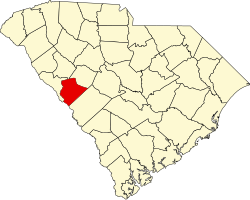North Augusta, South Carolina | |
|---|---|
 Downtown North Augusta | |
| Nickname: South Carolina's Riverfront | |
 Interactive map of North Augusta | |
| Coordinates: 33°30′47″N81°58′46″W / 33.51306°N 81.97944°W [1] | |
| Country | United States |
| State | South Carolina |
| Counties | Aiken, Edgefield |
| Incorporated | April 11, 1906 |
| Founded by | James U. Jackson |
| Government | |
| • Type | Mayor–council |
| • Mayor | Briton Williams [2] (R) |
| Area | |
• Total | 21.84 sq mi (56.57 km2) |
| • Land | 21.29 sq mi (55.14 km2) |
| • Water | 0.55 sq mi (1.43 km2) |
| Elevation | 469 ft (143 m) |
| Population | |
• Total | 24,379 |
| • Density | 1,145.1/sq mi (442.11/km2) |
| Time zone | UTC−5 (Eastern (EST)) |
| • Summer (DST) | UTC−4 (EDT) |
| ZIP codes | 29800-29899 |
| Area codes | 803, 839 |
| FIPS code | 45-50695 [5] |
| GNIS feature ID | 2404389 [1] |
| Website | www |
North Augusta is a city in Aiken and Edgefield counties in the U.S. state of South Carolina, on the north bank of the Savannah River. It lies directly across the river, and state border, from Augusta, Georgia. The population was 24,379 at the 2020 census, making it the 21st-most populous city in South Carolina. [6] The city is included in the Central Savannah River Area (CSRA) and is part of the Augusta, Georgia, metropolitan area.





